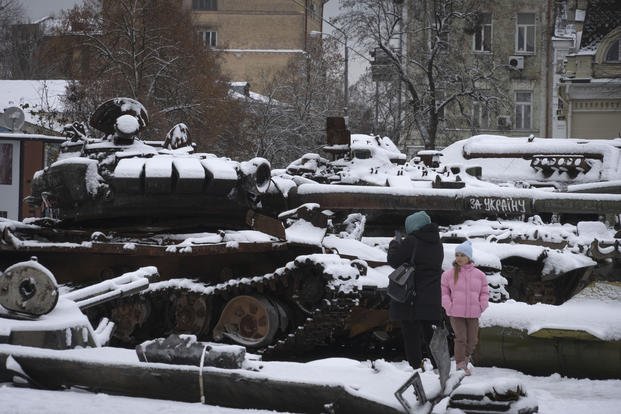Russia is running low on ammunition as its Ukraine invasion careens toward the one-year mark, and it may soon be forced to use older, unreliable rockets and artillery shells -- some built decades ago, according to a senior U.S. military official.
The new ammunition, what the Pentagon calls "fully serviceable," could be used up by early next year as the war continues despite the winter weather, said the official, who briefed the press Monday on the condition of anonymity. Russia also appears to be running low on precision-guided munitions.
Moscow is faced with relying more heavily on degraded rockets and shells, which could ratchet up risks to its own troops and leave unexploded ordnance strewn across Ukraine, or finding some way to replenish new stocks despite international sanctions designed to stamp out its war effort.
Read Next: VA Starts Early Review of Claims for Veterans With Terminal Illnesses Under the PACT Act
"So, this essentially puts Russian forces in a position to have to make a choice about what risks it's willing to accept in terms of increased failure rates, unpredictable performance, and whether or not these degraded conditions [of older ammunition] would require any type of refurbishment, which of course requires a certain amount of expertise and time," the official said.
Earlier this month, Avril Haines, the director of national intelligence, told a gathering of U.S. officials in California that Russia was using up ammunition at a "really pretty extraordinary" rate and faster than its own defense industry could replace it, according to NBC News.
Even at the beginning of the war, when Russian President Vladimir Putin ordered the invasion on Feb. 24, his forces have at times used the aging rockets and shells despite the risks of ammunition built as long ago as 40 years.
Degraded ammunition can injure or kill troops who fire it. "You load the ammunition and you cross your fingers and hope it's going to fire, or when it lands that it's going to explode," the official said.
But unexploded ordnance can also contaminate battlefields long after wars end and threaten generations of civilians, meaning Ukraine could be saddled with the danger and cleanup if it successfully repels the Russian invasion.
Many Pacific Island nations still struggle with unexploded ordnance dropped during World War II, according to the State Department. In Afghanistan, one of the most war-torn countries in the world, more than 20,000 people are estimated to have been injured or killed by unexploded ordnance between 2001 and 2018, according to a study by Brown University's Costs of War Project.
Ultimately, the Russians will likely try to replenish their stocks of new ammunition through domestic production, refurbishment of old stocks and foreign suppliers, the official said. "This is why it's not surprising that they're reaching out to countries like Iran and North Korea to try to obtain some more dependable ammunition."
Evidence from the battlefield shows Russia has already been relying on Iranian-made drones. On Dec. 10 alone, the Ukrainians reported that Russian forces waged 15 separate attacks on three cities using the drones, according to the Institute for the Study of War.
But the U.S. has warned nations that might consider trading with Russia that they too could be sanctioned. Dozens of countries have levied sanctions against Moscow, and about 1,000 multinational companies have announced they will reduce operations in Russia due to its invasion, putting its economy under immense pressure.
Meanwhile, Russia's defense spending spiked 40% in the first months of the war, Reuters reported, and Putin has plans to boost spending by 43% in the coming year, according to Bloomberg News.
Deputy U.S. Treasury Secretary Wally Adeyemo said in October that his agency issued "guidance making clear that we are willing and able to sanction people, companies or countries that provide ammunition to Russia or support Russia's military-industrial complex."
Existing sanctions crippled Russia's ability to produce weapons and replace those destroyed in Ukraine, and blocked it from getting microelectronics needed by its military industrial complex, according to the Treasury Department.
Beyond the ammunition shortage, Russia has faced a raft of troubles including logistics breakdowns, low morale and high casualty rates after nearly 10 months of fighting in Ukraine.
Putin ordered the invasion with hopes of quickly capturing the capital Kyiv and dismantling the independent democratic government led by Ukraine President Volodymyr Zelenskyy, who has received historic backing from nations around the world.
As U.S. officials routinely point out, none of that has been achieved, although intense fighting has continued amid significant Ukrainian gains in the eastern part of the country. Zelenskyy, who was named Time's Person of the Year this month, has turned out to be a worthy opponent to Putin and his military.
Defense Secretary Lloyd Austin said Ukraine is likely to keep the upper hand over Russia this winter due to Moscow's difficulty supplying troops and low morale, which is likely to be heightened as it has begun forcing veterans back into service to continue the war.
-- Travis Tritten can be reached at travis.tritten@military.com. Follow him on Twitter @Travis_Tritten.
Related: Ukraine Has the Edge Against Russia as Winter Descends, US Defense Secretary Says














